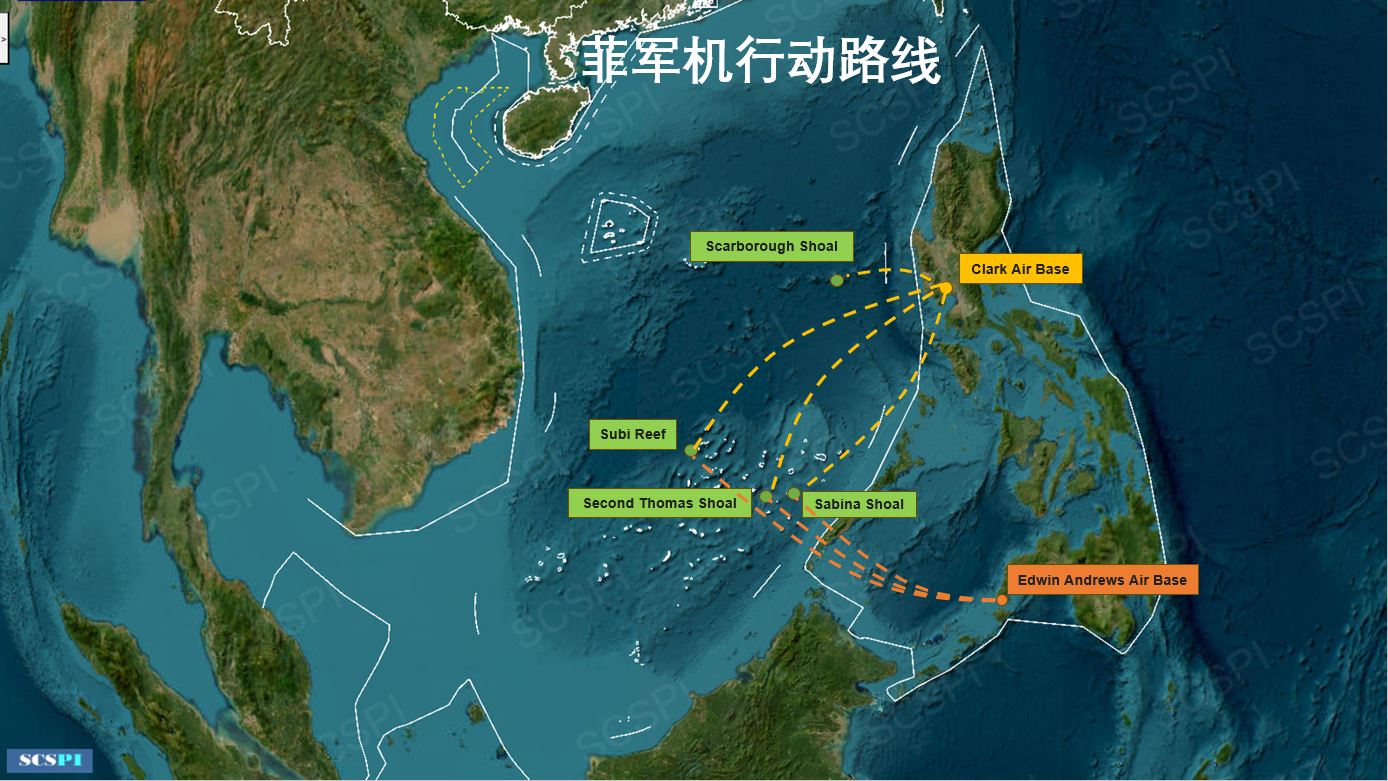Since August 2024, the Philippines has repeatedly dispatched military aircraft to trespass into the airspace of the Spratly Islands and Macclesfield Bank, escalating tensions in the region. On August 7 and 8, the Philippines sent an NC-212i aircraft to intrude into the airspace near Scarborough Shoal for two consecutive days, disrupting China's regular training activities. On August 19, a Cessna 208B Grand Caravan plane (C-208B) was dispatched to illegally enter the airspace of Scarborough Shoal. On August 22, the Bureau of Fisheries and Aquatic Resources of the Philippines again sent a C-208B to illegally intrude into the vicinity of Subi Reef.
In addition to intruding into the airspace of South China Sea islands and reefs, the Philippines has repeatedly deployed military aircraft for aerial supply drop missions at sea. On January 21, a C-208B was sent to supply the illegally grounded BRP Sierra Madre at Second Thomas Shoal through a low-altitude airdrop. On April 27, using an NC-212i aircraft, the Philippines conducted an airdrop operation at Flat Island, Spratly Islands, employing two methods: a direct low-altitude parachute drop onto the island, and a drop into the nearby sea for retrieval by soldiers. On May 19, a BN-2A light utility aircraft airdropped food and other supplies to BRP Sierra Madre. On August 28, a Philippines H-145 helicopter airdropped supplies to the Philippine Coast Guard vessel 9701, which was anchored at Sabina Shoal.
As China strengthens its maritime control, the Philippines has exhausted its options for maritime violations, prompting aerial trespassing to become another method for the Philippines to provoke tensions in the South China Sea.
Currently, the Philippines primarily employs two types of aircraft for patrol missions in the South China Sea: the C-208B and the NC-212i. The C-208B, a multipurpose single-engine turboprop aircraft gifted by the US government, is known for its durability and versatility. It can remain airborne for over five hours and 30 minutes, covering missions up to 912 nautical miles, and is mainly used for intelligence, surveillance, and reconnaissance.[1] The first two C-208Bs were officially delivered to the Philippine Air Force (PAF) in July 2017 and transported to Edwin Andrews Air Base in Zamboanga. The third arrived in September 2023 at Clark Air Base in Luzon.[2]
The NC-212i is a multi-purpose turboprop aircraft with a high payload capacity and a top speed of 230 miles per hour. It is utilized for maritime patrol, surveillance, reconnaissance, search and rescue, and various civil and quasi-military missions.[3] The PAF now operates two NC-212is, ordered from PT Dirgantara Indonesia (PTDI) by the Department of National Defense, which entered service in June 2018 at Clark Air Base. In April 2023, the Philippines signed another contract with PTDI to acquire six more NC-212i aircraft. The sixth unit, featuring underwing drop tanks for extended range, is expected to be delivered within 46 months.[4]
Chief of Staff of the Armed Forces of the Philippines, Romeo Brawner Jr., noted that larger, slower aircraft like the NC-212i are better suited for maritime aerial patrols, while faster aircraft like the FA-50 have limitations in scouting islands and sea conditions.[5]

Philippine Secretary of National Defense Gilbert Teodoro has stated that the Philippines is considering deploying FA-50PH fighter jets to escort aircraft conducting patrol missions in the South China Sea. The Philippines possesses 12 FA-50PHs from South Korea, which are primarily used for air combat, ground attack and training. These jets can reach speeds of up to 1.5 Mach (1,155 miles per hour), making them the only fixed-wing platform in the PAF with attack capabilities. Recently, the Philippine Armed Forces have been testing the FA-50PH’s ability to launch illumination flares in the South China Sea region.[6]
Due to the where the features controlled by various parties are often located in the same reefs or lagoon and their airspaces are overlapping and intertwining, reports of intrusions from multiple parties are common. However, this situation differs markedly from the Philippines' attempts to alter the status quo through intrusive actions or aerial resupplies. Lately, the Philippines has significantly intensified its patrols, resupplies and intrusions into Chinese-occupied features in its so-called "West Philippine Sea," introducing new risks and uncertainties.
On one hand, the risks and uncertainties associated with aerial encounters, especially confrontational ones, are much higher than those at sea. If the Philippines continues its intrusions, China will have to take corresponding measures, and any aerial friction or collision could result in far more serious consequences than a typical maritime collision.
On the other hand, the Philippine aircraft in use are primarily single-engine turboprop light utility aircraft, which are less equipped to handle complex maritime environments, increasing the likelihood of accidents during frequent operations. Moreover, Philippine military aircraft usually operate with ADS-B transponders turned off throughout their missions, posing potential safety risks. In the event of an accident, whatever the reasons, based on past behavior, the Philippines would likely blame China, leading to another cycle of victim-playing and diplomatic posturing.
At the moment, because of the Philippines’ insistence on changing the status quo, maritime friction and collisions between China and the Philippines have become increasingly common. Simultaneously, with the Philippines escalating aerial provocations, the risks of aerial encounters and tensions are also rising, necessitating close attention and vigilance.

